With our WSHP V3 Concept
Following in the same ideas as the Air-Cooled condensing series, the WSHP V3 concept utilizes the same engineering strategy; using head pressure control techniques which includes building water flow modulation. Lately, our engineering team conceived a new design of WSHP that are not only performing, but also extremely rigid and robust. This high level of quality coupled with our construction rigidity easily distinct Annexair WSHP from the competition. All model sizes are piped with rigid copper gauge tubing, each compressor has vibration absorber, and receiver is included for each package as standard. Also, an electronic Carel controller is used for operation and includes a remote controller display mounted in the control panel of the air handling unit.

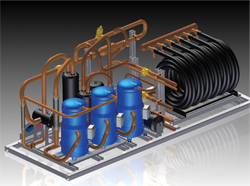
Example of a 48-ton AquaMod WSHP
|
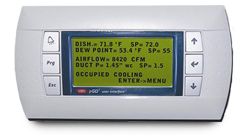
Remote Carel Controller - Perfect tool for monitoring low & high pressures of each compressor circuit and other functions.
|
Engineered to Minimize Energy Costs
|
It’s no secret that refrigeration systems are costly to operate. Continuous setpoint satisfaction is the reason why these systems require greater amounts of energy. We designed our V3 technology to radically reduce energy requirements and even eliminate all peak loads at unit start-up, helped by our soft-start compressors and their 30 to 90Hz modulating capability. For example, a 22-ton unit will modulate from 7 to 22 tons, a 30-ton unit will modulate from 5 to 30 tons and a 70-ton unit will modulate from 7 to 70 tons.
Figure 1 demonstrates the modulating capacities of several WSHP sizes available, from the minimum to maximum capacities including EER value for 30, 60, and 90 Hz operation.
|

Figure 1 |
Designed for Maximum Comfort
Designing an affordable refrigeration system that delivers increased comfort and savings is a challenge. By using only variable speed compressors combined with the exact water flow (GPM) required, we have created the perfect sequence to maintain comfort levels and avoid wasting energy.
|
Figure 2
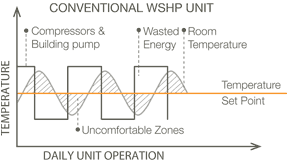
Figure 2 shows how conventional WSHP units continuously cycle on and off, wasting energy and affecting comfort level.
|
Figure 3
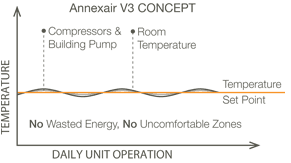
Figure 3 illustrates how our V3 Concept requires less power to maintain comfort levels and how it eliminates ON/OFF cycling. Supply temperature can be held at ± 0.1°F of desired setpoints. As a result, annual unit operating costs can be 15 to 30% less.
|
Full Load vs. Part Load
|
Even though units are designed for Full Load operation, the reality is that they will run most of the time in Part Load operation. Units that cannot match design requirements with a certain accuracy result in wasted energy when working at Part Load. Figure 4 below demonstrates the actual Full Load vs. Part Load requirement for 5 major cities in the United States. The graph represents an analysis of 25 years of bin data for each city collected from ASHRAE weather data and compiled to demonstrate the percentages of Full Load and Part Load operation. Full Load operation is maintained for a maximum of 2% during the year while the remainder is considered Part Load operation. Part Load capacity ranges have been divided into 3 zones represented by different colors. Considerable energy savings are obtained due to the impressive quantity of hours at Part Load.
Figure 4 Digits in columns (%) represent the outdoor air temperature annual frequency of operation that exceeds
|

Figure 4 |
50°F dew point. Take note that full load zones (dark gray) have been defined for systems operating between 96 to 100% of ASHRAE city design conditions; 96% and below are defined as part load zones. Data is based on ASHRAE 2009 Weather Viewer Dew Point Bin Data.
Smart Head Pressure Control Delivers Optimal Performance
Similar to our Air-Cooled V3 Concept, our WSHP series come standard with smart head pressure control which modulates all compressors to maintain desired supply setpoint. In addition, our advanced control logic limits the building water flow (GPM) to the minimum required amount for the condensing unit. As a result for the building owner, the pump can reduce its speed if equipped with a VFD. This unique concept consumes the least amount of energy and delivers maximum comfort by always running in the optimal range.
New Compressor Technology That Saves Energy
|
Traditional systems address part load conditions with unloading techniques (for example with hot gas bypass), multiple compressors, or by using digital compressor technology. These solutions are inefficient either because high compressor efficiency cannot be maintained at part load or because the load matching ability is limited. Hot gas bypass is an alternative solution, but it also wastes a significant amount of energy.
The VSH compressor made by Danfoss, which is designed to maintain high isentropic efficiency and has the inherent benefit of matching the load precisely and continuously by operating from 30 Hz to 90 Hz. With no excess evaporator and condenser capacity under part load, the compressor COP is higher and delivers significant energy savings. Also, because it is in continuous operation, this means less cycling and system stress, higher reliability and a longer lifespan. Helped by the Annexair unit PLC, the supply desired setpoint can be exceptionally precise; it can be as accurate to 0.1°F.
|
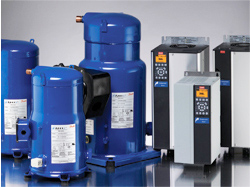
 |
Each compressor come equipped with a factory programmed VFD keypad which graphically displays multiple parameters: hertz, amps, load capacity %, etc. It’s a great tool for monitoring, troubleshooting and maintenance. These values are also displayed on the unit PLC and accessible to the BMS via BACnet or LonWorks.
|
|
Additional savings are also achieved because the power factor remains above 0.90 regardless of load and drive controller logic ensures soft starts that reduce inrush current. Depending on project location, V3 Technology energy savings can be 15 to 30% greater than conventional systems.
High Effectiveness Heat Exchanger
Annexair uses coaxial tube-in-tube design for all our WSHP exchangers. All of these condenser coils operate very effectively as either refrigerant condensers or refrigerant evaporators when transferring heat with water. This makes them an ideal choice for both water-source heat pumps and water-cooled condenser applications. Water flows through the inner tube while refrigerant flows in the annulus between the inner and outer tubes.
|
The key to the high performance of these coils lies in the convoluted multi-lead inner tube. The resulting tubes increase heat transfer surface area per unit length yet still permit full flow of both water and refrigerant around its entire periphery for improved performance. The net result is a highly effective, compact heat exchanger with superior anti-fouling characteristics. Optimum heat transfer is also achieved with a counter-flow arrangement of water and refrigerant during condensing.
|
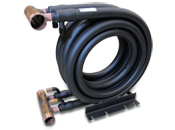 |
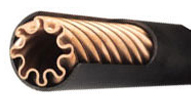 |
Annexair offers optional copper or cupro-nickel inner tubes with steel out tubes. Copper inner tubes are recommended for fresh and cooling tower water applications while cupro-nickel is recommended for ground and sea water applications.
|